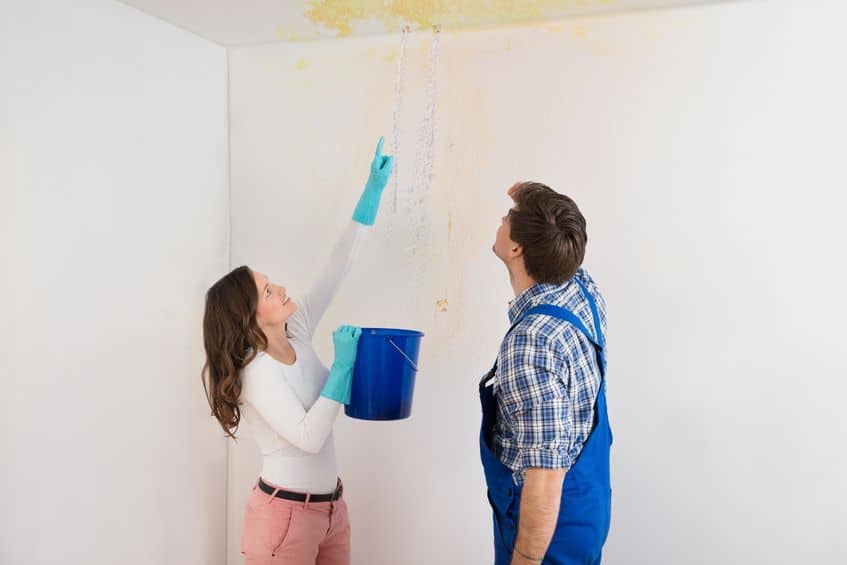
Think you have a leak but you’re not sure? Pretty sure you have a leaky pipe somewhere, but can’t find out where? Professional water “leak detection” services cover both situations — detecting a leak and locating its source. And that’s important as a hidden leak can quickly cause thousands of dollars of water damage.
Did You Know? Water damage insurance claims total more than twice that for burglaries and exceed those of fire damage claims.
Water Leak Detection: Do I Have a Leak?
You should suspect a leak if you’ve noticed any of the following.
- water stains on the wall, floor, or ceiling
- damp, warm or moldy spots
- mold or other odors
- warping or buckling flooring
- bowing walls or sagging ceilings
- the sound, dripping, spraying, or running water
- a jump in water usage on your utility bill
You can do a quick check yourself by shutting off everything that might use water then carefully watching your water meter reading. If the reading changes, there’s a leak. But a plumber can do a more sensitive test by using a sensitive meter to measure any loss of pressure with everything, including the main supply, shut down. In commercial buildings an experienced plumber can often isolate various sections of plumbing to narrow down the leak location based on pressure tests alone.
Sewer Lines
Sewer pipes can leak too. Here you’re most likely to notice the problem from its smell. Or you may notice a wet or unusually lush area of lawn. A plumber can perform a hydro-static test by blocking the end of the line, filling it with water, and seeing if that water slowly leaks away.
Leak Location: Where is It?
Water can flow quite a distance inside building cavities before it reveals itself. So tracking down the exact location of the source can be tricky. That once meant making an educated guess, then making several holes in walls, floors, or ceilings until it was actually found. Thanks to the latest technology there’s several options for non-destructive leak location depending on the situation. But they all require training and experience to be used effectively.
- Line tracing is perhaps the oldest electronic technique. Using a low-powered radio-frequency transmitter the pipe becomes an antenna. A small receiver allows accurately tracing where the pipe runs inside building cavities.
- Acoustic leak detection is an advanced-technology version of an “ear to the wall” strategy. The latest equipment uses sensitive microphones to pick up the ultrasonic (ultra-high frequency) sounds of water or compressed air escaping from a crack or small hole. Electronics filters out traffic noise and other distractions while a read-out of volume lets the user zero-in on the location.
- Thermal imaging uses digital cameras that see in infrared light, not unlike those in fighter jets and heat-seeking missiles. They can detect temperature differences of just a small fraction of a degree and display that as a false-color picture. The leak is most likely where the temperature difference is greatest from surrounding areas.
Running several feet below ground, pinpointing a leak in sewer line poses a different challenge. An in-pipe sewer line video inspection will spot a problem, and cameras with a radio transponder make it possible to determine the location and depth.
Flooding Alarms
Most home flooding incidents are the result of failed plumbing or appliances, not rainstorms. Such problems dump hundreds of gallons per hour, so the sooner they’re stopped the less damage there will be. With water damage restoration bills coming in on the order of $10,000 it’s well worth investing in an alarm. There are two basic types, and premium models of either can include a valve that automatically turns off the water supply.
- Flooding alarms detect the first signs of standing water on the floor. They’re relatively inexpensive and can be user-installed in places such as around clothes washers, dishwashers, and water heaters.
- Flow alarms measure how much water is used minute by minute, then employ computer algorithms to provide a leak indication.
You can learn about some specific products from the following links.
https://restechtoday.com/guide-5-modern-leak-detectors/
https://www.techhive.com/article/3138905/best-water-leak-detectors-for-smart-homes.html
https://www.safety.com/water-leak-detectors/

